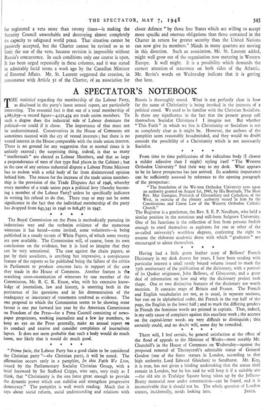A SPECTATO R'S NOTEBOOK T HE statistics regarding the membership of
the Labour Party, as disclosed in the party's latest annual report, are particularly interesting. The essential fact is that out of a total membership of 4,685,659—a record figure-4,031,434 are trade union members. To such a degree does the industrial side of Labour dominate the political—or could if it chose. The importance of that must not be underestimated. Conservatives in the House of Commons are sometimes taunted with the cry of vested interests ; but there is no vested interest in the House comparable with the trade union interest. There is no ground for any suggestion that at normal times it is unfairly exerted ; the surprising thing, indeed, is that so many "intellectuals " are elected as Labour Members, and that so large a preponderance of men of that type find places in the Cabinet ; but in the case of any serious industrial dispute a Labour Prime Minister has to reckon with a solid body of far from disinterested opinion behind him. The reason for the increase of the trade union member- ship is the provision of the Trade Disputes Act of 1946, whereby every member of a trade union pays a political levy (thereby becom- ing a member of the Labour Party) unless he specifically indicates in writing his refusal to do that. There may or may not be some significance in the fact that the individual membership of the party has dropped from 645,345 in 1946 to 608,487 in 1947.


































 Previous page
Previous page